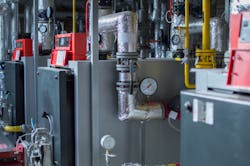In my last article we’d started to look at the instruments necessary for setting up the boiler. Today’s boilers are extremely sophisticated, and require the use of a combustion flue gas analyzer in order to properly set them up to ensure proper operation. The good ol’ days of a bang bang boiler (either on or off) are long gone. Today’s boilers come with turndown ratios that result in having to test the appliance at a minimum of three different points on the appliance’s modulating scale. One at its highest burn, one at the lowest burn and then one test at mid-range. Your analyzer must be able to read the oxygen content, excess air content, carbon dioxide, and carbon monoxide.
Most of the off the shelf portable analyzers that are available today should be able to read these gases. Some jurisdictions require the ability to also read Nitrous Oxide (NOX) outputs as well, and I expect the rest of the country will be looking to achieve the same goals. NOX is the gas that makes up most of the smog, and anything that can be seen visually, becomes something that everyone wants to reduce as much as possible, so you probably ought to take this into consideration when making the tool purchase decision. Testing of gas fired appliances during the non-heating load seasons can be rather tricky, especially with larger boilers. In most cases, with a smaller boiler that also does DHW, you simply exert a good sized DHW load on the system and do your combustion analysis during this load. With larger commercial systems, creating conditions that will allow for a long-term burn are difficult, and you may have to postpone this one test until the weather is conducive to operating the boiler. Each burner assembly will have a factory specification that the boilers and burners must be set up to conform to. This may require some adjustments by the field technician that may require the services of a factory representative, until which time they are comfortable with the field tech making their own adjustments. Some boiler manufacturers include the commissioning process as a part of the boilers installation package, but most do not, and it is the responsibility of the installing contractor to make certain that the appliance is as close to factory specification as is humanly possible.
Not performing a combustion analysis is tantamount to malpractice in our field. If you don’t know, you’re guessing.
Regardless of your choice as it pertains to combustion analysis devices, I always recommend that the technicians charged with using these devices receive training from not only the analyzer manufacturer, but also from the boiler manufacturer. It is rare that two different appliance manufacturers use the exact same gas train and or blower assembly that will carry over from one maker to the next, and its best to know the nuances of the individual appliance before attempting any field adjustments. Having received training from one of this industry’s best, Mr. Jim Davis, I also strongly recommend that the instrument be initialized outside the building in which it will be used. This is done so that in the off-hand chance that there is a flue gas leak within the building, that the spillage will not affect the initialization of the test instrument. I’d also strongly recommend that your technicians be outfitted with personal CO monitoring devices, so that if they do walk into a dangerous situation, that they are made aware of it before it becomes a life-threatening situation.
Most appliance manufactures of modulating type have the ability to set the controls up in a “test” mode, which allows the commissioner the ability to turn the burner rate to the different positions of testing. This is where you will get your low, medium and high burn outputs for purposes of testing. Most combustion analyzer manufacturers also have a read out in Percent Efficiency. In my humble experience and personal opinion, if you have the ability to turn this readout off on the analyzer, I’d strongly recommend that you do so. There are no less than a thousand different ways to get to a given number of efficiency, and it distracts the technician away from the factors that are relevant and important to the operation of the appliance. I’ve watched rookie technicians work with these instruments, and the only number that they saw and understood was the percent efficiency number. Unfortunately, that is the last number the technicians need to be looking at, hence why I recommend turning that feature off on the instrument. If you can’t afford to send all of your technicians to an analyzer/boiler class, consider training one employee, and then have him teach your other technicians as to what they need to know and understand. Not performing a combustion analysis is tantamount to malpractice in our field. If you don’t know, you’re guessing, and someone’s life could be on the line. Documentation is just as important as the act of testing, so be certain to print out copies of the analysis and keep one copy in the boiler room, and another in a remote permanent file.
Mark Eatherton material, in print and online, is protected by Copyright 2017. Any reuse of this material (print or electronic) must first have the express written permission of Mark Eatherton and CONTRACTOR magazine. Please contact via email at [email protected].
About the Author
Mark Eatherton
Mark Eatherton material on this website is protected by Copyright 2017. Any reuse of this material (print or electronic) must first have the expressed written permission of Mark Eatherton and CONTRACTOR Magazine.
